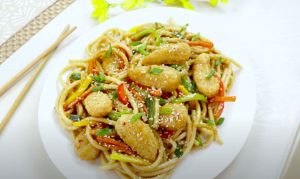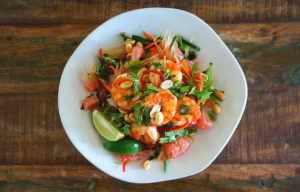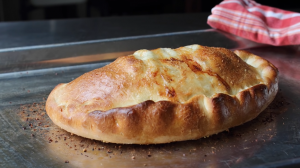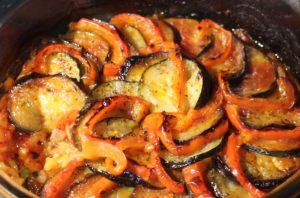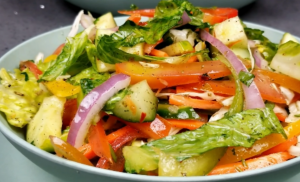Genmaicha, a traditional Japanese tea, combines the earthy flavors of green tea with the nutty, toasted essence of brown rice. This unique blend offers a comforting, warm beverage perfect for any time of day.
One key ingredient you might not have on hand is brown rice. It is essential to use brown rice because it provides the toasted, nutty flavor unique to genmaicha. Additionally, green tea leaves are needed, preferably loose-leaf for the best flavor. Both items should be available at most supermarkets, particularly those with a good selection of international or Asian foods.
Ingredients for Genmaicha Recipe
brown rice: Provides the toasted, nutty flavor characteristic of genmaicha
water: The base for brewing the tea
green tea leaves: Adds the earthy, vegetal flavor that complements the toasted rice
One reader, Jerald Helms says:





This genmaicha recipe is fantastic! The toasted brown rice adds a delightful nutty flavor that perfectly complements the green tea. It's easy to make and incredibly soothing. Highly recommend for a cozy, relaxing drink.
Techniques for Brewing Genmaicha Tea
How to toast rice: Toast the brown rice in a small skillet over medium-low heat until it turns dark in spots. How to simmer: After bringing the water to a boil, reduce the heat to low, cover the saucepan, and let it simmer for 1 minute. How to steep: Allow the mixture to steep off the heat for 3 minutes, then add the tea and let it steep for another 3 minutes. How to strain: Strain the mixture to remove the rice and tea leaves from the liquid before serving.
How To Make Genmaicha Recipe
Start your day with a cup of this Japanese tea to keep you focused. This Genmaicha recipe combines green tea leaves and brown rice for a relaxing drink.
Serves:
Ingredients
- 2tbspbrown rice
- 4cupswater
- 4tspgreen tea leaves
Instructions
-
Put the rice in a small skillet and toast over medium-low heat until it turns dark in spots. Move to a small saucepan.
-
Pour in the water and bring to a boil. Immediately reduce the heat to low, then cover and simmer for 1 minute.
-
Remove from heat and allow to steep for 3 minutes more. Add the tea and let it steep for another 3 minutes.
-
Strain and discard the rice and tea leaves from the liquid.
-
Serve the tea hot and enjoy.
Nutrition
- Calories: 21.54kcal
- Fat: 0.16g
- Saturated Fat: 0.03g
- Monounsaturated Fat: 0.06g
- Polyunsaturated Fat: 0.06g
- Carbohydrates: 4.52g
- Fiber: 0.20g
- Protein: 0.45g
- Sodium: 9.77mg
- Calcium: 9.07mg
- Potassium: 16.26mg
- Iron: 0.11mg
Technique Tip for Achieving the Perfect Genmaicha Flavor
Toasting the brown rice until it turns dark in spots enhances its nutty flavor, which is essential for authentic genmaicha. Be patient and toast the rice over medium-low heat to avoid burning it, ensuring a balanced and rich taste in your tea.
Time-Saving Tips for Preparing Genmaicha Recipe
Toast rice in bulk: Toast a larger batch of brown rice and store it in an airtight container. This way, you can skip this step next time.
Use a kettle: Boil the water in an electric kettle to speed up the process instead of using a saucepan.
Pre-measure tea leaves: Measure out the green tea leaves in advance and store them in small containers or bags for quick access.
Steep efficiently: Use a timer to ensure you don't over-steep the tea, which can save you from having to redo the process.
Substitute Ingredients For Genmaicha Recipe
brown rice - Substitute with white rice: White rice can be used as a substitute because it has a similar texture and can be toasted to achieve a comparable flavor profile.
brown rice - Substitute with barley: Barley can be toasted and used in place of brown rice, offering a nutty flavor that complements the green tea.
water - Substitute with coconut water: Coconut water can add a subtle sweetness and unique flavor to the tea, though it will alter the traditional taste.
green tea leaves - Substitute with sencha tea leaves: Sencha tea leaves provide a similar grassy and fresh flavor, making them a suitable replacement for green tea leaves.
green tea leaves - Substitute with matcha powder: Matcha powder can be used for a more intense green tea flavor, though it will change the texture and appearance of the tea.
Presenting Genmaicha Tea: Tips for Serving
Serve in elegant teacups: Choose fine porcelain or ceramic teacups to enhance the visual appeal and elevate the experience of enjoying genmaicha.
Garnish with toasted rice: Lightly sprinkle a few pieces of toasted brown rice on top of the tea for a subtle crunch and visual contrast.
Accompany with a small sweet: Pair the genmaicha with a delicate Japanese sweet, such as a mochi or wagashi, to complement the tea's flavors.
Use a bamboo tray: Present the teacups on a traditional bamboo tray to add an authentic touch and enhance the overall presentation.
Add a tea strainer: Include a small, elegant tea strainer on the side to emphasize the care taken in preparing the genmaicha.
Incorporate fresh elements: Place a small sprig of mint or a slice of citrus on the tray for a pop of color and freshness.
Serve at the perfect temperature: Ensure the genmaicha is served hot but not scalding, allowing the flavors to be fully appreciated by the culinary professionals.
Essential Tools for Making Genmaicha Tea
Small skillet: Used to toast the brown rice until it turns dark in spots, enhancing its flavor.
Small saucepan: Used to combine the toasted rice with water and bring it to a boil, then simmer.
Measuring spoons: Essential for accurately measuring the brown rice and green tea leaves.
Measuring cup: Used to measure the water needed for the recipe.
Stove: Provides the heat source for toasting the rice and boiling the water.
Lid: Used to cover the saucepan while the mixture simmers, ensuring even cooking.
Strainer: Used to remove the rice and tea leaves from the liquid, leaving you with a clear tea.
Teapot or serving pot: Used to serve the hot genmaicha tea.
Teacups: For serving and enjoying the hot tea.
Storing and Freezing Brewed Genmaicha Tea
- To store leftover genmaicha, allow it to cool completely to room temperature before transferring it to an airtight container or jar.
- Seal the container tightly to prevent any air or moisture from entering, which can affect the flavor and freshness of the tea.
- Store the container in a cool, dry place away from direct sunlight, such as in a pantry or cupboard.
- Properly stored, genmaicha can last up to 2-3 days at room temperature.
- For longer storage, you can refrigerate the tea in an airtight container for up to 5 days.
- To freeze genmaicha, pour the cooled tea into an ice cube tray and place it in the freezer until the tea is frozen solid.
- Once frozen, transfer the tea cubes to a freezer-safe bag or container, label it with the date, and store it in the freezer for up to 3 months.
- To thaw frozen genmaicha, simply place the desired number of tea cubes in a mug and let them melt at room temperature, or microwave them for a few seconds until they melt.
- Alternatively, you can add the frozen tea cubes directly to a glass of cold water or sparkling water for a refreshing iced tea drink.
- Keep in mind that the flavor and aroma of the tea may slightly diminish over time, so it's best to consume frozen genmaicha within 1-2 months for optimal taste.
Reheating Leftover Genmaicha Tea
The best way to reheat leftover genmaicha is to pour it into a small saucepan and heat it over medium-low heat until it reaches your desired temperature. This method ensures that the tea doesn't become too hot or bitter, and it allows the flavors of the brown rice and green tea to meld together once again.
Another option is to use a microwave. Pour the leftover genmaicha into a microwave-safe mug or bowl and heat it in 30-second intervals, stirring between each interval, until it reaches your desired temperature. Be careful not to overheat the tea, as this can cause it to become bitter.
If you prefer your genmaicha iced, you can simply pour the leftover tea over a glass filled with ice cubes. This method works best if the leftover tea has been stored in the refrigerator and is already chilled.
For a more creative approach, try using leftover genmaicha as a base for a smoothie. Blend the chilled tea with your favorite fruits, such as bananas, berries, or mango, and a scoop of vanilla yogurt for a refreshing and healthy treat.
If you find yourself with a large amount of leftover genmaicha, consider using it as a cooking liquid for rice or quinoa. The nutty, slightly sweet flavor of the tea can add depth and complexity to your grains, making for a unique and delicious side dish.
Interesting Facts About Genmaicha Tea
A unique aspect of genmaicha is that it combines green tea with toasted brown rice, creating a distinctive flavor profile. This blend was originally developed in Japan as a way to make tea more affordable by adding rice.
Is Making Genmaicha Tea at Home Cost-Effective?
The genmaicha recipe is highly cost-effective for a household. With just brown rice, water, and green tea leaves, the ingredients are minimal and inexpensive. The approximate cost for a household of 4 people is around $2-$3 USD. Given its simplicity, health benefits, and affordability, this recipe scores a solid 9 out of 10 in terms of cost-effectiveness.
Is Genmaicha Tea Healthy or Unhealthy?
This genmaicha recipe is generally considered healthy due to its simple, natural ingredients. Green tea is rich in antioxidants, particularly catechins, which have been linked to various health benefits such as improved heart health, weight management, and reduced risk of certain cancers. The brown rice adds a nutty flavor and a small amount of dietary fiber to the beverage.
However, there are a few aspects that could be improved to make this recipe even healthier:
- Use organic brown rice and green tea leaves to minimize exposure to pesticides and other harmful chemicals
- Consider using a higher quality green tea, such as matcha or gyokuro, which contain higher levels of beneficial compounds
- Avoid adding any sweeteners or creamers to the tea, as these can add unnecessary calories and sugar
To further enhance the health benefits of this recipe, you could try the following:
- Steep the tea for a shorter time (1-2 minutes) to avoid extracting too much caffeine and tannins, which can be bitter and potentially harmful in large amounts
- Combine the genmaicha with other healthy ingredients, such as fresh ginger, lemon, or mint, to add flavor and additional nutritional benefits
- Enjoy the genmaicha as part of a balanced diet and healthy lifestyle, including regular exercise and stress management techniques
Editor's Thoughts on This Genmaicha Tea Recipe
This genmaicha recipe is a delightful blend of nutty and grassy flavors, thanks to the toasted brown rice and green tea leaves. The process of toasting the rice adds a unique depth, while the short steeping times ensure a balanced, not overly bitter brew. However, I would recommend rinsing the rice before toasting to remove excess starch and enhance the clarity of the tea. Overall, it's a simple yet sophisticated recipe that captures the essence of traditional Japanese tea.
Enhance Your Genmaicha Recipe with These Unique Side Dishes:
Alternative Japanese Tea Recipes to Try
Why trust this Genmaicha Recipe:
This genmaicha recipe is a delightful blend of toasted brown rice and green tea leaves, offering a unique and authentic taste. The process of toasting the rice enhances its nutty flavor, while the green tea provides a refreshing and soothing finish. Carefully crafted and tested, this recipe ensures a perfect balance of flavors. Trust in the simplicity and tradition behind this method to enjoy a comforting cup of genmaicha.
Was this page helpful?
Have your own special recipe to share? Submit Your Recipe Today!



